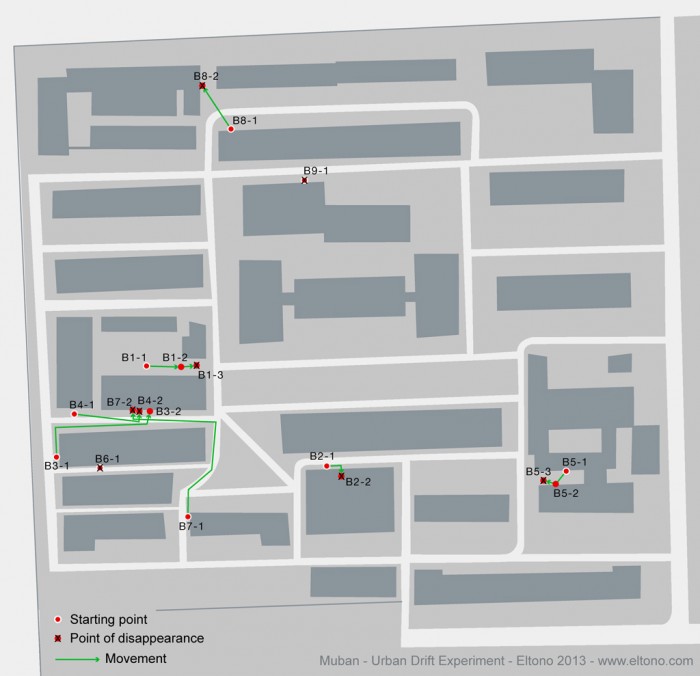Muban (木板, “wood board” in Chinese)
Urban drift experiment with wooden boards
Beijing, China 2011 – 2013
Muban is an experiment about movement and material recuperation. Since I moved to China, I have been observing how people constantly recycle everything – from cardboard boxes and plastic bottles to bricks, doors and windows from demolished buildings. These materials are immediately collected and sold by the kilo or directly reused. I wanted to see what would happen if I threw my own material out onto the street. where would it end up? How would it be used? I bought some thin plywood boards, and had them cut (81 x 61 cm). On either side of each board I painted white shapes to be able to spot them easily. Each board was given a slightly different design so I could differentiate and follow them. Then, I left them in the street and waited to see what would happen.
Muban A, Caijing donglu
One day on my way to my daily Chinese classes, I found a shortcut passing through a “hutong” neighborhood. I found it so interesting, compared with the rest of the over-urbanized area around, that I decided to pass through there everyday. The people living there were very kind, always smiling and open to communication. I decided to do the first Muban experiment in this neighborhood because it was quite small, had one story homes and very few residents lived there. Furthermore, as I was walking or biking through it everyday, I would be able to observe the pieces and how they moved twice a day. I prepared the first nine Mubans in my studio and one night, I deposited them around the tiny hutong streets. I distributed the boards into four sets: one containing three boards and the other three containing two. They disappeared very fast and, only once (18 days later), was I able to see a set of two boards (A6 and A7) reappear again in an adjacent street before it was completely gone. I abandoned the nine boards in November of 2011 and I continued to observe until the summer of 2012. Today this neighborhood is almost completely gone. Most of the people have lost their homes and have been forced to move somewhere else in order to build more towers and skyscrapers.
Click on the images to enlarge them and read the captions to follow the story.
Muban A1, A4 and A5:
Muban A2 and A9:
Muban A3 and A8:
Muban A6 and A7:
This is how this hutong neighborhood looks today (June 2013). In almost every picture you can see some tall buildings surrounding the area – this is what they’ve planned to build here, more towers, once the last residents have been kicked out.
Muban B, Chengfulu
Things got a little bit better with the second experiment, I got a couple of very interesting results and I was able to draw a map of the movements. I painted nine boards again and I deposited them, one by one this time, in a small residential area very close to my house. Since then, I have walked around or biked through this neighborhood almost everyday trying to spot the boards. After so many hours observing and looking for the white geometric designs, I developed a new ability and was able to detect them quite easily.
Click on the images to enlarge them and read the captions to follow the story.
The records of Muban B1 to B9 are presented in chronological order.
Muban B1:
Muban B2:
Muban B3:
Muban B5:
Muban B4:
Muban B9:
Muban B8:
Muban B6:
Muban B7:
I learned many interesting things while doing the Muban project such as how to be discreet to avoid ruining the experience, how to appear lost when you know exactly where you are going and a variety of interesting habits and quirky personality traits belonging to the Beijingers who live in these communities. This experiment is an ongoing project. The pieces must be observed for a very long time so it’s not an easy project to start just anywhere. I’m looking forward to continuing with it and I hope to be able to report more results. If by any chance, any of the above listed Mubans reappear, I’ll post the update here.































































































